This post may contain affiliate links. Please see our disclosure policy.
Vegetable soup is a comfort food classic, and you can make your own simple vegetable soup for canning with fresh, healthy ingredients.

Homemade vegetable soup is my go-to recipe when I’m feeling under the weather. I know many people reach for home-canned chicken soup, but there’s something about chunky vegetables in a rich tomato broth that just screams nourishment to my body.
The problem is, I usually crave vegetable soup in the middle of winter when those inevitable cold weather colds pop up…not in late summer when all these tasty vegetables are ripe and fresh.
The solution? Canning vegetable soup!
With this simple pressure canning recipe for vegetable soup, you can have homemade vegetable soup right out of a jar on your pantry shelf any day of the year.
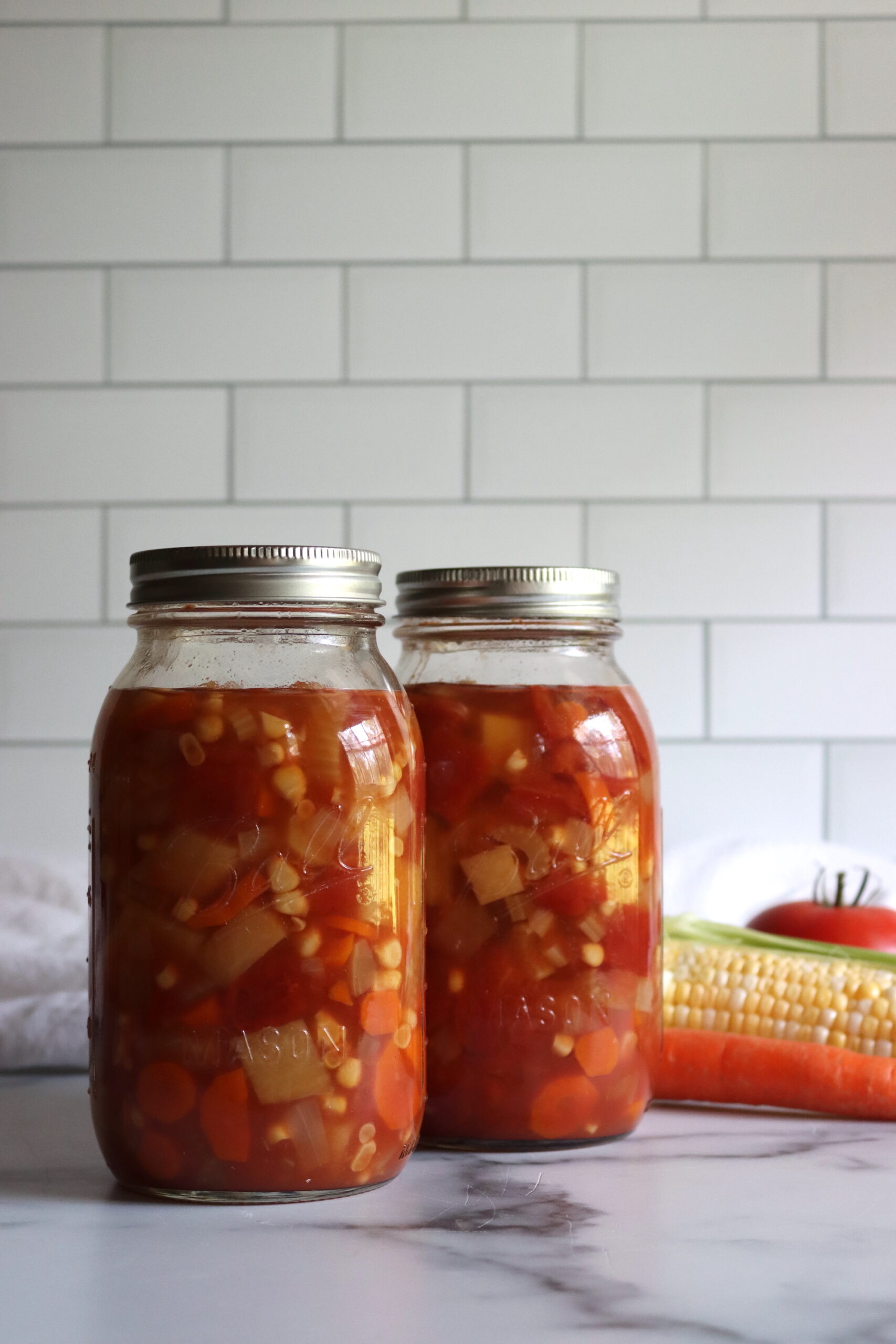
Ingredients for Canning Vegetable Soup
This tested canning recipe for vegetable soup comes from the Ball Blue Book Guide to Preserving, and it’s a classic recipe that home canners have been using for generations. To make a canner batch of 14 pints or 7 quarts of canned vegetable soup, you will need the following:
- 2 quarts chopped tomatoes (12 medium tomatoes)
- 1 ½ quarts potatoes, cubed (9 medium potatoes)
- 1 ½ quarts sliced carrots (12 medium carrots)
- 1 quart whole uncooked kernel corn (8 medium ears)
- 2 cups sliced celery (4 stalks)
- 2 cups chopped onions (2-3 medium)
- 1 quart lima beans (Optional, I don’t add these)
- 1 ½ quarts water or vegetable broth
- Salt and pepper to taste, I use about 2 Tbsp salt (optional)
The above list of ingredients is one that has been tested and published in the Ball Book of Canning. Personally, I don’t like lima beans and it’s not something we grow in our home garden, so I don’t add them to my vegetable soup. You’re allowed to omit most vegetables from canning recipes (just not tomatoes, as they add acidity and liquid to the batch). You can leave out the corn, onions, celery, carrots, or potatoes to suit your tastes. Just know your yield will be slightly less and you cannot add other veggies to make up the difference.
It’s important to note that you should not add ingredients like rice, pasta, flour, milk, cream, or other thickening agents to this recipe or any other canned soup recipe.
Feel free to add spices and herbs as well. Good options include rosemary, sage, parsley, and garlic. These will not affect the safety of your finished product.
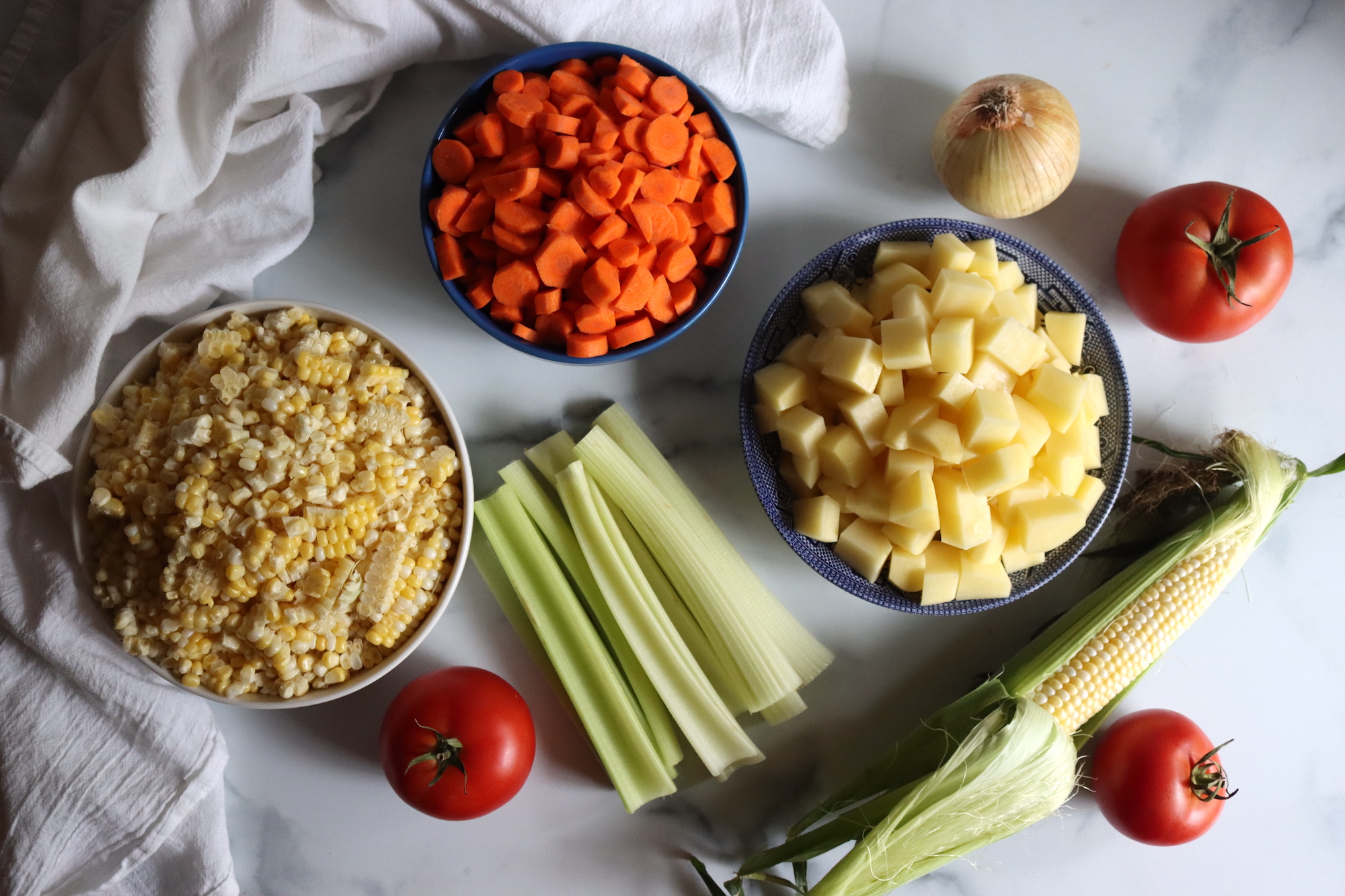
Canning Vegetable Soup
Begin by washing all of your vegetables, including the potatoes, tomatoes, carrots, celery, corn, and even the lima beans, under cold water. Drain.
Your next step is to peel the tomatoes. To do this, blanch them for 30-60 seconds in boiling water. Immediately transfer them to cold water. Remove the peel (depending on the variety, it may slide right off, or you can cut it off). Core the tomatoes, measure out two quarts, and set aside.
Peel the potatoes, then cut them into half-inch cubes. Measure out 1 ½ quarts of potatoes, then set aside.
Remove the stem from the carrots and peel, then slice them ¼ of an inch thick. Measure out 1 ½ quarts of sliced carrots, then set aside.
Cut the corn from the cob, then measure out a quart of whole-kernel corn. Set aside.
Remove the root end and leafy tops from the celery, then cut it into one-inch slices. Measure out two cups of sliced celery, and set aside.
Peel and chop the onions. Measure out two cups of chopped onions, then set aside.
Next, add all of your ingredients (except the salt and pepper) to a large saucepan. Bring to a boil, then reduce the heat to a simmer (or around 180 degrees Fahrenheit, if you’re able to measure with a thermometer). Simmer for 15 minutes, then season with salt and pepper to taste, if you choose.
The Ball Book doesn’t give any guidance on the amount of salt to use, and “t0 taste” is pretty darn vague. In general, home-canned soups use about 3/4 to 1 tsp of salt per quart. For this canner batch of 7 quarts, I use 2 tablespoons (or about 6 tsp), which comes out just right to my taste. Use more or less to suit your family, and know that you can always add more salt at serving…but once it’s in there, you can’t take it back.
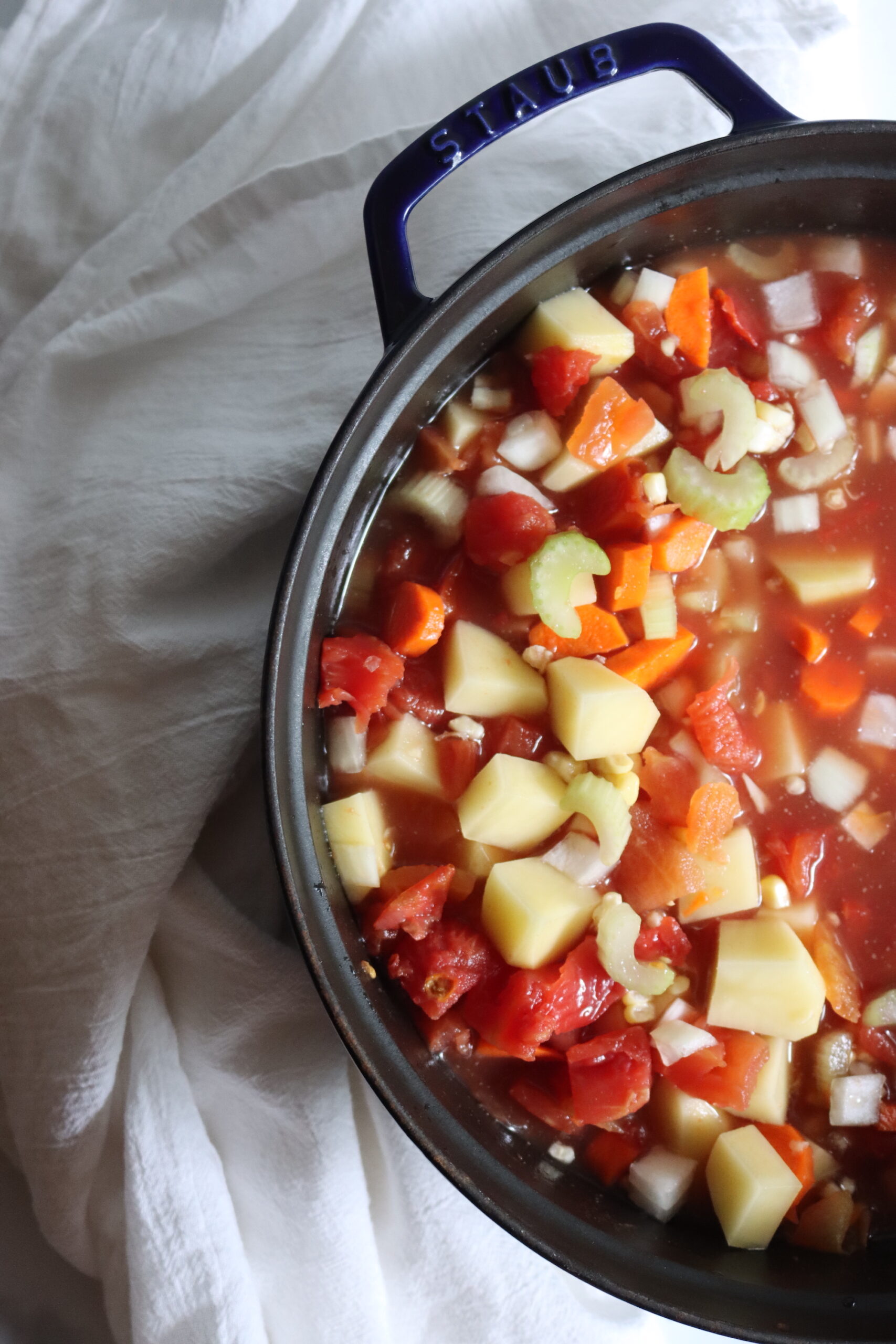
Ladle the hot soup into sterilized hot jars. Leave one inch of headspace. Remove any air bubbles, then clean the rim of the jar to remove food particles. Place the lids and rings on the jars, then adjust until they are fingertip-tight. Load the jars into the canner and add two inches of simmering water.
Put the lid on your canner and turn it to the locked position. Adjust the heat to medium-high heat, then vent steam for 10 minutes. Put the gauge on the vent, if using a weighted gauge canner (adjust accordingly for dial gauge canning), then bring the pressure to 10 lbs. Adjust for altitude if needed (see below).
Process pint jars for 55 minutes or quart jars for 85 minutes (1 hour and 25 minutes). Turn off the heat, then allow the canner to depressurize on its own. Remove the lid, then take out the jars. Let them cool for 24 hours before storing. Be sure to label the jars and check the seals before you store them!
Altitude Adjustments
With pressure canning, the processing times stay the same at higher altitudes, but the pressures change. Here are the altitude adjustments for pressure canning vegetable soup:
For dial gauge pressure canners:
- 0 to 2,000 feet in elevation – 11 lbs pressure
- 2,001 to 4,000 feet in elevation – 12 lbs pressure
- 4,001 to 6,000 feet in elevation – 13 lbs pressure
- 6,001 to 8,000 feet in elevation – 14 lbs pressure
For weighted gauge pressure canners:
- 0 to 1,000 feet in elevation – 10 lbs pressure
- Above 1,000 feet – 15 lbs pressure
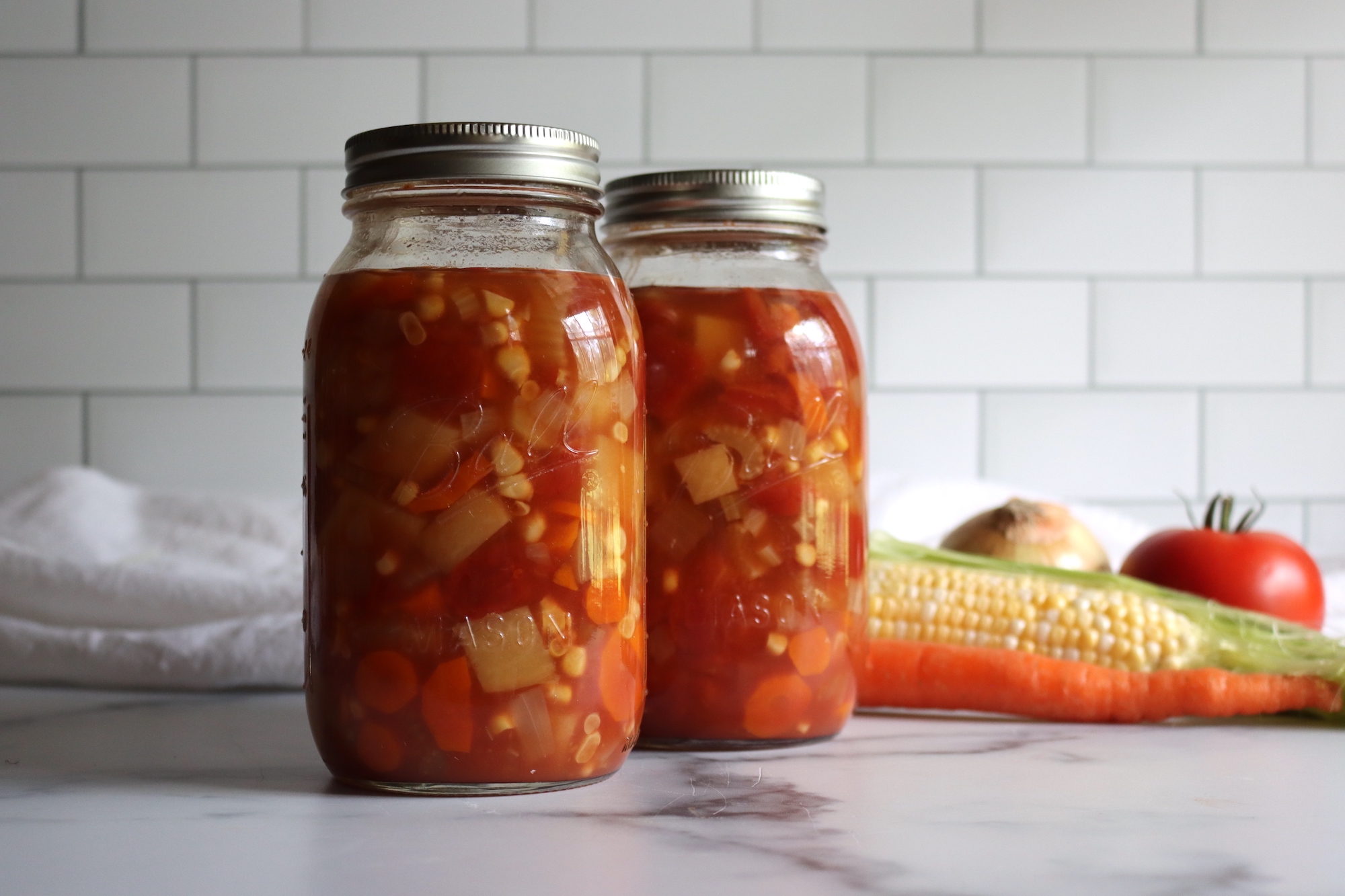
Serving Vegetable Soup
There are many delicious and creative ways to serve canned vegetable soup. To serve this canned vegetable soup, all you really need to do is pour it into a bowl and reheat.
But there are so many other options as well! To make a complete meal, pair it with a fresh, colorful salad and some homemade crunchy garlic bread.
For a more traditional approach, ladle the soup into a hollowed-out sourdough loaf for an interesting presentation.
Serve the soup with grilled cheese sandwiches or your favorite comfort food for a delicious weeknight dinner.
If you’re looking to put your own spin on traditional vegetable soup, fix it up with delicious accompaniments like diced avocado, shredded cheese, crumbled bacon bits, and sliced jalapeño. A few drizzles of hot sauce will bring out even more flavor in your soup as well!
Vegetarian Canning Recipes
There’s more than one way to preserve plant-centered recipes in a jar! Try any of these vegetarian canning recipes:

Classic Vegetable Soup
Equipment
Ingredients
- 2 Quart tomatoes, chopped, 12 medium tomatoes
- 1 ½ Quart potatoes, cubed (9 medium potatoes)
- 1 ½ Quart carrots, sliced, 12 medium carrots
- 1 Quart corn, whole uncooked kernel corn, 8 medium ears
- 2 cups celery, sliced, 4 stalks
- 2 cups onions, chopped, 2-3 medium
- 1 Quart lima beans, optional
- 1 ½ Quart water or vegetable broth
- Salt and pepper to taste, about 2 Tbsp. Salt, and 1-2 tsp pepper (optional)
Instructions
- Wash all vegetables under cold water. Drain.
- Peel the tomatoes by blanching them for 30-60 seconds in boiling water, then transferring them immediately to hot water. Remove the peel by sliding or cutting it off, then core the tomatoes. Measure out two quarts and set them aside.
- Peel and cube the potatoes (½” cubes). Measure out 1 ½ quarts, then set aside.
- Peel and slice the carrots into ¼” thick slices. Measure out 1 ½ quarts, then set aside.
- Cut the corn from the cob and measure out a quart of kernels. Set aside.
- Cut the celery into 1″ slices. Measure out two cups of sliced celery and set aside.
- Peel and chop the onions, then measure out two cups and set aside.
- Add all ingredients to a saucepan (except the salt and pepper). Bring to a boil and reduce the heat to a simmer, simmering for 15 minutes.
- Season with salt and pepper if desired.
- Ladle the mixture into hot, sterilized jars, leaving 1″ of headspace. Remove air bubbles, wipe the rims, then add lids and rings. Tighten until your fingertips are tight.
- Load the jars into the canner and add 2″ of water.
- Put the lid on the canner and adjust to the locked position. Turn the heat on to medium-high and vent steam for 10 minutes. Add the gauge to the vent, if using a weighted 0 gauge canner.
- Bring the pressure to 10 lbs, adjusting for altitude if needed.
- Process pint jars for 55 minutes or quart jars for 1 hour and 25 minutes. Turn off the heat, then let the canner depressurize.
- Remove the jars and allow them to cool for 24 hours. Label the jars and check the seals before storing.
Notes
Altitude Adjustments
With pressure canning, the processing times stay the same at higher altitudes, but the pressures change. Here are the altitude adjustments for pressure-canning vegetable soup:For dial gauge pressure canners:
- 0 to 2,000 feet in elevation – 11 lbs pressure
- 2,001 to 4,000 feet in elevation – 12 lbs pressure
- 4,001 to 6,000 feet in elevation – 13 lbs pressure
- 6,001 to 8,000 feet in elevation – 14 lbs pressure
For weighted gauge pressure canners:
- 0 to 1,000 feet in elevation – 10 lbs pressure
- Above 1,000 feet – 15 lbs pressure
Nutrition
Nutrition information is automatically calculated, so should only be used as an approximation.
Soup Canning Recipes
There are so many different soup canning recipes out there, try these for your pantry:
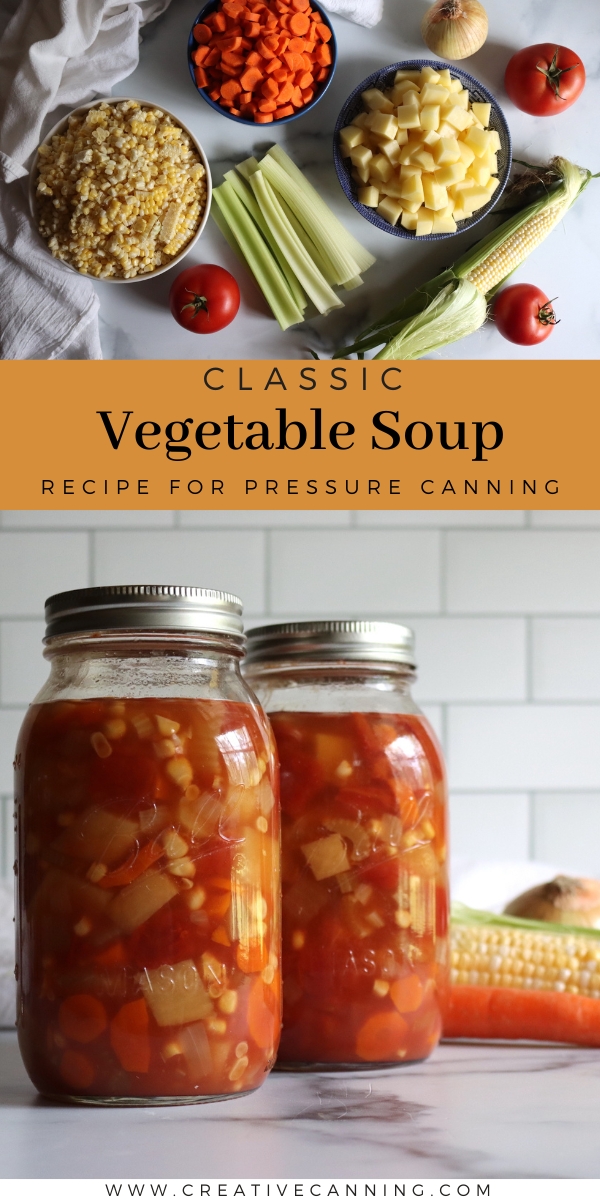
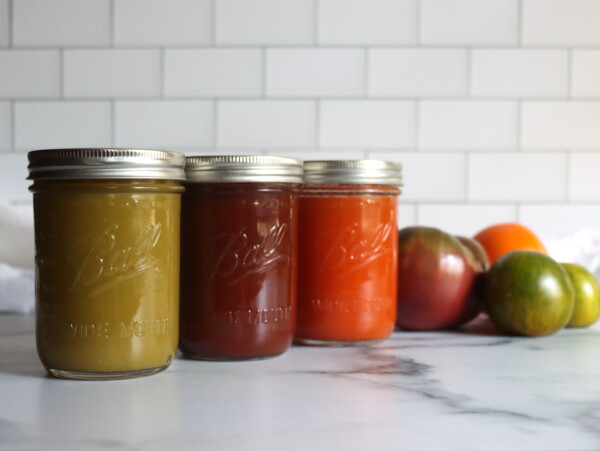
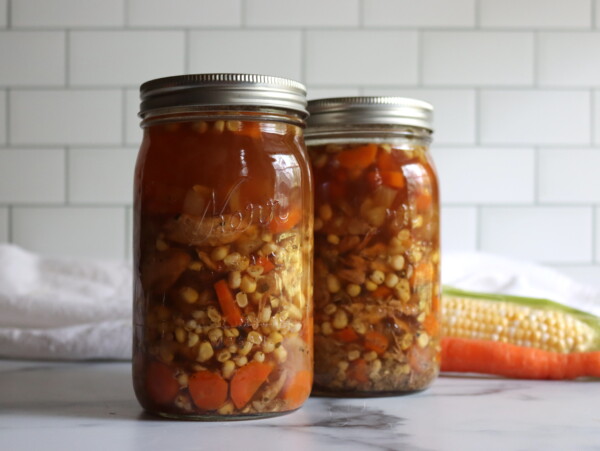
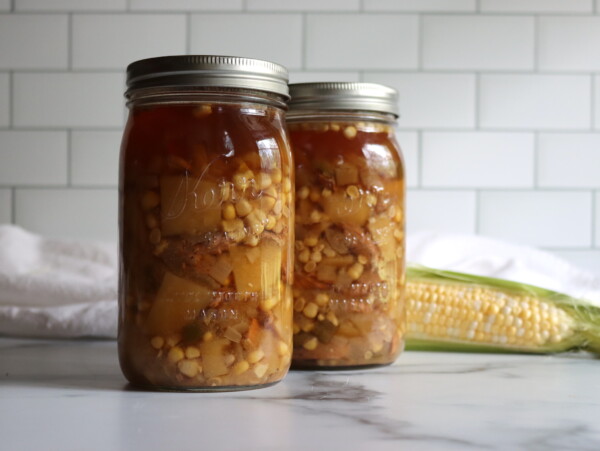
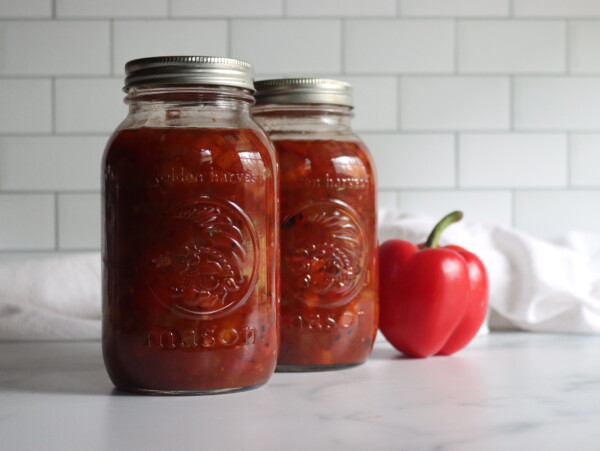
Can you use can tomatoes
Yes, you can use canned tomatoes in this recipe. You’d use the same volume of canned diced tomatoes. Don’t drain the cans, just use them as they are with the liquid. Enjoy!
Can you use frozen vegetables in place of the fresh ones?
Yes, with this recipe you can use frozen veggies. Some veggies have odd texture issues if they were pre-frozen, and you may find that in the finished soup. However, if you normally use those same frozen veggies in your cooking and don’t mind the texture, then it’ll be not much different when canned, so you should be fine. Enjoy!
Why can you not add other vegetables if you omit the ones in the recipe?
Some types of veggies increase the density of the finished product. There have recently been new instructions from the NCHFP that allow you to customize soup recipes, and the canning times are slightly longer. If you wanted to change the veggies in this recipe, follow the guidance for “hearty soups” given here: https://creativecanning.com/choice-soup-canning-recipe/
Thank you! That was such a help!
You’re quite welcome!
Why don’t you put approximately how many quarts or pints that your recipes will make? That way people could an make educated guess of the number of recipes to make for their needs.
At the top of the recipe card, in the header it says “Servings: 14 servings, Makes 14 pints or 7 quarts.” The text of the blog post also lists the yield under the ingredients section (To make a canner batch of 14 pints or 7 quarts of canned vegetable soup, you will need the following…).
Hope this helps!
I lost the recipe I used for my pressure cooker and am so excited to find this! It looks to be exactly the one I used several years ago! I had shoulder surgery and had not been able to can. This is the best recipe ever, perfect for winter suppers with a grilled cheese sandwich! Thank you for providing this recipe
You’re quite welcome!
I made 16 pints . There was just enough left for me to eat for my supper.
I thought it was very savory and quite delicious..
So glad you enjoyed it!
Is there any adjustments to this recipe if I’m using the Presto Electric canner?
No adjustments needed. You can make this as is in the presto electric, no problem. Enjoy!
This looks so good! Can you use a water bath canner or freeze it?
You can’t use a waterbath canner, but you can freeze it. Waterbath canners only work for things that are acidic (jams, jellies, pickles), anything with meat or veggies needs to be pressure canned.